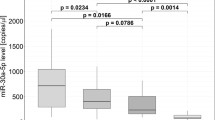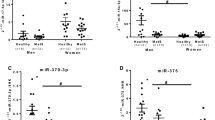Abstract
MicroRNAs (miRNAs) are small noncoding RNAs that negatively regulate gene expression. Though their significance is unclear, pioneer profiling studies have attributed specific serum miRNA signatures to different disease conditions. The diagnostic potential of miRNA detection in human plasma for cardiovascular disorders is beginning to be recognized as important. In this study, we examined miRNA profiling in isolated diastolic dysfunction (DD) with preserved systolic function to identify promising candidate miRNAs. The presence of these miRNAs was tested in stable patients with isolated DD, patients with stable compensated dilated cardiomyopathy (DCM—systolic plus diastolic dysfunction) and those with decompensated congestive heart failure secondary to dilated cardiomyopathy (DCM–CHF—systolic plus diastolic dysfunction). We identified new circulating miRNAs (miR-454, miR-500, miR-1246, miR-142-3p) which showed distinct patterns of expression in patients with diastolic dysfunction. The presence or absence of systolic dysfunction does not seem to affect this trend. MiR-454 and miR-500 are downregulated in diastolic dysfunction. MiR-1246 is upregulated in diastolic dysfunction. MiR-142-3p is downregulated in DCM and DCM–CHF groups but not in the DD group. The expression of miR-124-5p is highly upregulated in DCM but not in DD and DCM–CHF groups. We therefore propose that these circulating miRNAs may serve as novel biomarkers for diastolic dysfunction because in all of these patients the only common factor was diastolic dysfunction.



Similar content being viewed by others
References
Bartel DP (2004) MicroRNAs: genomics, biogenesis, mechanism, and function. Cell 116:281–297
Baek D, Villen J, Shin C, Camargo FD, Gygi SP, Bartel DP (2008) The impact of microRNAs on protein output. Nature 455:64–71
Selbach M, Schwanhausser B, Thierfelder N, Fang Z, Khanin R, Rajewsky N (2008) Widespread changes in protein synthesis induced by microRNAs. Nature 455:58–63
Chien KR (2007) Molecular medicine: microRNAs and the tell-tale heart. Nature 447:389–390
Gupta R, Soni N, Patnaik P, Sood I, Singh R, Rawal K, Rani V (2010) High AU content: a signature of upregulated miRNA in cardiac diseases. Bioinformation 5:132–135
Zhao Y, Ransom JF, Li A, Vedantham V, von Drehle M, Muth AN, Tsuchihashi T, McManus MT, Schwartz RJ, Srivastava D (2007) Dysregulation of cardiogenesis, cardiac conduction, and cell cycle in mice lacking miRNA-1–2. Cell 129:303–317
Brattelid T, Aarnes EK, Helgeland E, Guvaag S, Eichele H, Jonassen AK (2011) Normalization strategy is critical for the outcome of miRNA expression analyses in the rat heart. Physiol Genomics 43:604–610
Wang J, Zheng Z, Lin FQ, Sun CC, Xu RX, Hu SS (2010) miRNA changes in the reverse remodeling heart of rats. Zhonghua xin xue guan bing za zhi [Chin J Cardiovasc Dis] 38:745–750
Lin RC, Weeks KL, Gao XM, Williams RB, Bernardo BC, Kiriazis H, Matthews VB, Woodcock EA, Bouwman RD, Mollica JP, Speirs HJ, Dawes IW, Daly RJ, Shioi T, Izumo S, Febbraio MA, Du XJ, McMullen JR (2010) PI3K(p110 alpha) protects against myocardial infarction-induced heart failure: identification of PI3K-regulated miRNA and mRNA. Arterioscler Thromb Vasc Biol 30:724–732
Ai J, Zhang R, Li Y, Pu J, Lu Y, Jiao J, Li K, Yu B, Li Z, Wang R, Wang L, Li Q, Wang N, Shan H, Yang B (2010) Circulating microRNA-1 as a potential novel biomarker for acute myocardial infarction. Biochem Biophys Res Commun 391:73–77
Corsten MF, Dennert R, Jochems S, Kuznetsova T, Devaux Y, Hofstra L, Wagner DR, Staessen JA, Heymans S, Schroen B (2010) Circulating microRNA-208b and microRNA-499 reflect myocardial damage in cardiovascular disease. Circ Cardiovasc Genet 3:499–506
Kuwabara Y, Ono K, Horie T, Nishi H, Nagao K, Kinoshita M, Watanabe S, Baba O, Kojima Y, Shizuta S, Imai M, Tamura T, Kita T, Kimura T (2011) Increased microRNA-1 and microRNA-133a levels in serum of patients with cardiovascular disease indicate the existence of myocardial damage. Circ Cardiovasc Genet 4(4):446–454
Cheng Y, Tan N, Yang J, Liu X, Cao X, He P, Dong X, Qin S, Zhang C (2010) A translational study of circulating cell-free microRNA-1 in acute myocardial infarction. Clin Sci 119:87–95
Wang GK, Zhu JQ, Zhang JT, Li Q, Li Y, He J, Qin YW, Jing Q (2010) Circulating microRNA: a novel potential biomarker for early diagnosis of acute myocardial infarction in humans. Eur Heart J 31:659–666
Sucharov C, Bristow MR, Port JD (2008) miRNA expression in the failing human heart: functional correlates. J Mol Cell Cardiol 45:185–192
Miyachi M, Tsuchiya K, Yoshida H, Yagyu S, Kikuchi K, Misawa A, Iehara T, Hosoi H (2010) Circulating muscle-specific microRNA, miR-206, as a potential diagnostic marker for rhabdomyosarcoma. Biochem Biophys Res Commun 400:89–93
Kosaka N, Iguchi H, Ochiya T (2010) Circulating microRNA in body fluid: a new potential biomarker for cancer diagnosis and prognosis. Cancer Sci 101:2087–2092
Asaga S, Kuo C, Nguyen T, Terpenning M, Giuliano AE, Hoon DS (2011) Direct serum assay for microRNA-21 concentrations in early and advanced breast cancer. Clin Chem 57:84–91
Bianchi F, Nicassio F, Marzi M, Belloni E, Dall’olio V, Bernard L, Pelosi G, Maisonneuve P, Veronesi G, Di Fiore PP (2011) A serum circulating miRNA diagnostic test to identify asymptomatic high-risk individuals with early stage lung cancer. EMBO Mol Med 3(8):495–503
Liu R, Zhang C, Hu Z, Li G, Wang C, Yang C, Huang D, Chen X, Zhang H, Zhuang R, Deng T, Liu H, Yin J, Wang S, Zen K, Ba Y, Zhang CY (2011) A five-microRNA signature identified from genome-wide serum microRNA expression profiling serves as a fingerprint for gastric cancer diagnosis. Eur J Cancer 47:784–791
Cortez MA, Calin GA (2009) MicroRNA identification in plasma and serum: a new tool to diagnose and monitor diseases. Expert Opin Biol Ther 9:703–711
Tie Y, Liu B, Fu H, Zheng X (2009) Circulating miRNA and cancer diagnosis. Sci China Ser C 52:1117–1122
Iborra M, Bernuzzi F, Invernizzi P, Danese S (2010) MicroRNAs in autoimmunity and inflammatory bowel disease: crucial regulators in immune response. Autoimmun Rev 11(5):305–314
Foss KM, Sima C, Ugolini D, Neri M, Allen KE, Weiss GJ (2011) miR-1254 and miR-574-5p: serum-based microRNA biomarkers for early-stage non-small cell lung cancer. J Thorac Oncol 6:482–488
Gui J, Tian Y, Wen X, Zhang W, Zhang P, Gao J, Run W, Tian L, Jia X, Gao Y (2011) Serum microRNA characterization identifies miR-885-5p as a potential marker for detecting liver pathologies. Clin Sci 120:183–193
Khan N, Cheng J, Pezacki JP, Berezovski MV (2011) Quantitative analysis of microRNA in blood serum with protein-facilitated affinity capillary electrophoresis. Anal Chem 83(16):6196–6201
Zahm AM, Thayu M, Hand NJ, Horner A, Leonard MB, Friedman JR (2011) Circulating microRNA is a biomarker of pediatric crohn disease. J Pediatr Gastroenterol Nutr 53:26–33
Adachi T, Nakanishi M, Otsuka Y, Nishimura K, Hirokawa G, Goto Y, Nonogi H, Iwai N (2010) Plasma microRNA 499 as a biomarker of acute myocardial infarction. Clin Chem 56:1183–1185
Tijsen AJ, Creemers EE, Moerland PD, de Windt LJ, van der Wal AC, Kok WE, Pinto YM (2010) MiR423-5p as a circulating biomarker for heart failure. Circ Res 106:1035–1039
Redfield MM, Jacobsen SJ, Burnett JC Jr, Mahoney DW, Bailey KR, Rodeheffer RJ (2003) Burden of systolic and diastolic ventricular dysfunction in the community: appreciating the scope of the heart failure epidemic. JAMA 289:194–202
Cohen J, Cohen J (2003) Applied multiple regression/correlation analysis for the behavioral sciences. L. Erlbaum Associates, Mahwah
Wang K, Zhang S, Marzolf B, Troisch P, Brightman A, Hu Z, Hood LE, Galas DJ (2009) Circulating microRNAs, potential biomarkers for drug-induced liver injury. Proc Natl Acad Sci USA 106:4402–4407
Vickers KC, Palmisano BT, Shoucri BM, Shamburek RD, Remaley AT (2011) MicroRNAs are transported in plasma and delivered to recipient cells by high-density lipoproteins. Nat Cell Biol 13:423–433
Hunter MP, Ismail N, Zhang X, Aguda BD, Lee EJ, Yu L, Xiao T, Schafer J, Lee M-LT, Schmittgen TD, Nana-Sinkam SP, Jarjoura D, Marsh CB (2008) Detection of microRNA expression in human peripheral blood microvesicles. PLoS One 3:e3694
Kosaka N, Iguchi H, Yoshioka Y, Takeshita F, Matsuki Y, Ochiya T (2010) Secretory mechanisms and intercellular transfer of microRNAs in living cells. J Biol Chem 285:17442–17452
Laios A, O’Toole S, Flavin R, Martin C, Kelly L, Ring M, Finn SP, Barrett C, Loda M, Gleeson N, D’Arcy T, McGuinness E, Sheils O, Sheppard B, J OL (2008) Potential role of miR-9 and miR-223 in recurrent ovarian cancer. Mol Cancer 7:35
Soper DS (2012) p value calculator for correlation coefficients (online software). http://www.danielsoper.com/statcalc3
Acknowledgments
This study was partly supported by start-up funds from the Texas A & M Health Science Center, College of Medicine, by an American Heart Association -National Scientist Development Grant (0835227 N) to S. Gupta (SG), and by a departmental grant from the Division of Cardiology, Scott & White Hospital (NN). We would like to thank Dr Gregory Dehmer for his time in reviewing this manuscript.
Author information
Authors and Affiliations
Corresponding authors
Electronic supplementary material
Below is the link to the electronic supplementary material.
Rights and permissions
About this article
Cite this article
Nair, N., Kumar, S., Gongora, E. et al. Circulating miRNA as novel markers for diastolic dysfunction. Mol Cell Biochem 376, 33–40 (2013). https://doi.org/10.1007/s11010-012-1546-x
Received:
Accepted:
Published:
Issue Date:
DOI: https://doi.org/10.1007/s11010-012-1546-x




